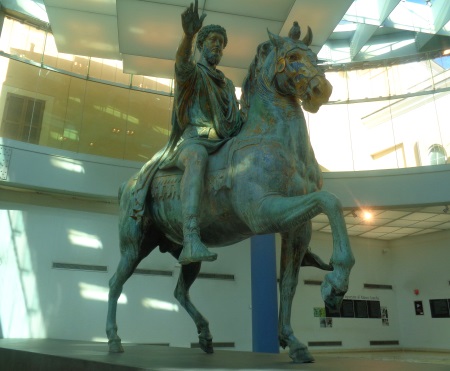Marcus Aurelius Equestrian Statue (Italian: Statua equestre di Marco Aurelio, English: Marcus Aurelius Equestrian Statue)
The main exhibit in the famous Capitolin Museum in Rome
Exploring the majestic equestrian statue of Marcus Aurelius: a remarkable 3.5 meter high work of art that is a must-see in the Capitoline Museum of Rome
As soon as you enter the halls of the famous Capitoline Museums in Rome, your attention is immediately drawn to the equestrian statue of Marcus Aurelius, a majestic figure that embodies the grandeur of ancient Rome. Dating from the 2nd century AD, this impressive masterpiece offers a glimpse into the artistic and historical wealth of the Roman Empire.

The statue
When you stand in front of this larger-than-life statue, you will be transported back to the time of Marcus Aurelius, one of the most revered Roman emperors. The approximately 3.5 meter high statue depicts the emperor sitting on a mighty horse and symbolizes military bravery and imperial power.
Admire the exquisite craftsmanship that goes into every inch of this equestrian wonder. From the intricate facial expressions to the carefully sculpted armor, the level of detail reflects the skills of ancient Roman artisans. The lifelike depiction of the horse frozen in a gallop contributes to the breathtakingly dynamic sculpture.
Meaning
The equestrian statue of Marcus Aurelius is of both great historical significance and aesthetic value. Known for his philosophical pursuits and military leadership, Marcus Aurelius ruled during an important period of Roman history. This statue captures the essence of his reign and provides a tangible connection to the past.
Our 3 articles about the Capitoline Museum:
The Capitoline Museum all information for visitors and an overview
Marcus Aurelius equestrian statue
symbolism
Discover the symbolism inherent in every aspect of the statue, from the emperor’s stoic expression to the horse’s powerful stance. Discover the layers of meaning intended to convey the Emperor’s message of leadership, power and divine right.
Important for travelers to Rome: We have only ever seen queues in Europe that are hundreds of meters long or several hours long in Rome. This is especially true for St. Peter’s Basilica, the Colosseum and the Vatican Museums. Be sure to buy skip-the-line tickets online beforehand and skip the queue!: There are such tickets on this link
Visitor tips
To have an even better experience during your visit, consider the following tips:
Tour: Take a guided tour to gain a deeper insight into the historical context and artistic nuances of the statue.
Photos: Capture the essence of this masterpiece. However, please follow the museum rules regarding photography.
As you complete your visit to the Capitoline Museums, the equestrian statue of Marcus Aurelius remains in your memory as a symbol of Rome’s wealth and culture. Its splendor not only adds to the museum’s charm but also enriches our understanding of the ancient world. Take the opportunity to stand in front of this equestrian statue.
Youtube videos on the topic
Marcus Aurelius
Marcus Aurelius, also known as Mark Aurel, was a Roman emperor and philosopher who reigned from 161 to 180 AD. He is best known for his philosophical writings and is considered one of the “Five Good Emperors” of Rome. A brief introduction to the life of Marcus Aurelius is as follows.
Birth, origin and family:
Marcus Aurelius was born in Rome on April 26, 121 AD.
His full name was Marcus Aurelius Antoninus. His uncle was Emperor Antoninus Pius, and Marcus was Antoninus’ adopted son and became his successor.
Education and early life:
Marcus Aurelius received a thorough education in rhetoric, philosophy and literature. He studied with renowned teachers.
Emperor Antoninus Pius and successor:
Antoninus Pius adopted Marcus Aurelius in 138 AD and made him heir to the Roman Empire. Mark became co-emperor with Antoninus in 161 AD and assumed full imperial power after Antoninus’ death in the same year.
Rule as Emperor:
Marcus Aurelius faced several challenges during his reign, including border wars with the Parthian Empire in the east and Germanic tribes in the north.
His reign is often associated with Stoic philosophy, as Marcus Aurelius was a follower of Stoicism. He wrote a series of personal philosophical reflections known as “Meditations,” which are considered classics of Stoic literature.
Philosophy and “meditation”:
Meditations is a collection of Marcus Aurelius’s thoughts on Stoic philosophy, personal virtue, and the nature of existence. These writings were not written for publication but were personal diaries for self-reflection.
Death:
Marcus Aurelius died on March 17, 180 AD during a campaign in the Danube region.
His son Commodus succeeded him as emperor.
Marcus Aurelius is remembered not only as an emperor, but also as a philosopher and king. His “Meditations” had a lasting influence on Western philosophy and continue to be studied for their insights into ethics and individual behavior. Despite the difficulties of his reign, Marcus Aurelius is generally respected for his devotion to duty and his philosophical approach to life.
Our tip: Buy tickets for Rome online in advanceFor some years now, there have been several large providers of tickets, entrance tickets, tours, etc. for your holiday You can buy entrance tickets for sights online in advance and save yourself queuing at the ticket office. You can also book bus tours, attractions, excursions and much more on the internet. We have picked out two good and reputable providers for you: 1. Getyourguide: Click here for Rome tickets 2. Tiqets: Click here for Rome tickets |